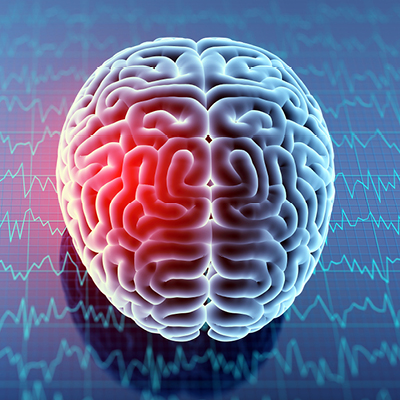Brain basics: What you should know about traumatic brain injuries
Posted March 14, 2022

From a car accident to a sports injury to an unfortunate fall to domestic violence or child abuse, all of these horrific scenarios can result in traumatic brain injuries, or TBIs. Head injuries can happen to anyone, at any age, and can damage the brain.
A TBI occurs when a sudden bump, blow or jolt to the head causes the brain to bounce or twist in the skull, injuring brain cells, breaking blood vessels, even creating chemical changes. It also can happen with a penetrating injury to the head, such as a gunshot wound.
TBIs can range from mild to severe. Mild TBIs, or mild concussions, can result in a brief change in consciousness, such as feeling dizzy or confused. A severe TBI, however, includes a longer period of unconsciousness, sometimes longer than one day, and can result in major problems with thinking and behavior.
But for patients who have experienced any type of head injury, it’s important they seek medical attention right away to diagnose and closely monitor their condition to help prevent further injury.
Summa Health sheds light on TBIs, who’s most at risk, symptoms and treatment because while most TBIs are mild, it’s important to know the facts so patients can get proper treatment and improve their outcomes if the unfortunate happens.
Who’s most at risk for traumatic brain injuries?
Anyone can experience a TBI, but they are more common in males and people older than age 65, according to the National Library of Medicine.
In addition, people in certain professions or activities are at a higher risk of a TBI, including:
- Athletes
- Construction workers
- Police and law enforcement
- Military members or veterans
What are common symptoms for traumatic brain injuries?
Typical symptoms of a mild TBI include:
- Headache
- Confusion
- Dizziness or lightheadedness
- Blurred vision
- Memory impairment or trouble concentrating
- Behavioral or mood changes
Symptoms of a severe TBI can include additional symptoms, such as:
- Repeated vomiting or nausea
- Slurred speech
- Weakness in the arms or legs, or loss of coordination
- Loss of consciousness
- Seizures
- Problems with thinking or learning
- Death
What is the diagnosis and treatment of traumatic brain injuries?
For any type of head injury, a provider will perform a neurologic exam and evaluate the person’s thinking, motor and sensory function, coordination and eye movement.
In addition, imaging tests, such as an MRI or CT scan, may be used to rule out some of the more serious conditions, such as brain swelling or bleeding. In severe injuries, doctors may place an intracranial monitor through the skull to observe the pressure.
The majority of TBIs are mild and treatment typically involves monitoring and rest. Its important patients follow their provider’s recommendations, however, for complete rest (physical and cognitive rest) and a gradual return to normal activity. Doing too much too soon can actually prolong recovery.
A person with a moderate to severe TBI, on the other hand, needs immediate medical attention to minimize secondary damage due to inflammation, bleeding or reduced oxygen supply to the brain. Surgery may be necessary to relieve pressure on the brain or remove blood.
Common surgeries performed by neurosurgeons (brain surgeons) for moderate to severe TBIs include:
- Hematomas: For bleeding on the outside of the brain, surgery will be performed to remove the clotted blood, which puts pressure on the brain and can damage the tissue.
- Repairing skull fractures: Surgery may be needed to repair severe skull fractures or to remove pieces of the skull in the brain.
- Repairing damaged tissue. Surgery may be necessary to remove damaged or dead brain tissue.
- Craniotomy: For bleeding found deeper inside the brain, surgeons will create an opening in the skull to drain fluid or blood from the brain. A plate and screws will be used to cover the hole.
- Craniectomy: In the most severe cases, surgeons will cut a piece of the skull off to create a “window” to enable cerebrospinal fluid to drain and allow more room for swollen tissues.
Doctors also may administer medications to limit further damage, such as anti-seizure drugs, coma-inducing drugs or diuretics to help drain fluid and pressure in the brain.
What is the prognosis for someone with a traumatic brain injury?
Recovery from a TBI is highly dependent on the individual, type of injury and severity. Older people and those who have experienced multiple head injuries, even if they were mild, can experience a longer recovery time.
People with a mild TBI typically improve and return to normal daily activities within a few weeks. Unfortunately, patients with moderate to severe brain injuries can experience life-long challenges due to significant changes to thinking and behavior and will require rehabilitation.
The type and duration of rehabilitation is different for everyone. Depending on the severity and location of the TBI, a wide range of therapists, including physical, occupational and speech therapists, and support will be necessary to help patients improve their abilities to perform daily tasks.
But whether patients suffered a mild or severe head injury, treatment and support are key to improving their condition and ultimately, their quality of life.
To learn about Summa Health's award-winning neurosurgery services, visit summahealth.org/brain or call 330.576.3500 to schedule an appointment.
Vitality eNews Sign Up
Receive the Summa Health eNewsletter for the latest health tips, advice and updates.

